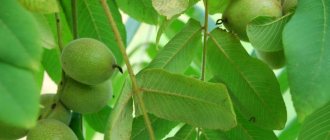What is okra?
In general, okra has quite a few names, which often leads to confusion and misunderstanding. You may also hear this plant called okra, gumbo, or lady's finger.
The plant is a low, squat bush that looks like a potato bush. But the fruits are more interesting. At first glance, they seem similar to hot pepper pods - elongated, not too long, rather narrow and with a slightly wavy surface. If you cut the pod, you can see the seeds inside the okra.
These fruits are actively used in cooking. However, you should know more about okra - this vegetable can bring both considerable benefit and serious harm. Here a lot depends on the person who will eat it. We'll talk about this in more detail a little later.
The described plant blooms with amazingly beautiful, large flowers with yellow petals and a dark center.
The pods for which okra is grown form every few days, so that several harvests can be harvested from one bush over the summer.
General characteristics
Okra, this southern plant, is quite difficult to name its homeland, because in the place where they learned about its beneficial properties, it was given a new name. In some places, okra is called gombo, okra, and even lady fingers in some places. This vegetable crop belongs to the Malvaceae family; okra began to be grown in our country quite recently.
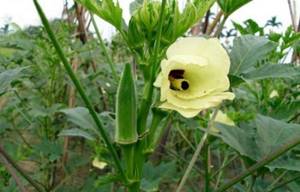
In appearance, okra resembles a pea pod, but only faceted and covered with small fibers. If you eat it raw, it tastes like spinach, and if you stew it, it tastes like zucchini or eggplant. You can only eat fresh okra fruits, even if they are slightly unripe; this can be determined by their size; the length of the pod will be about 10 cm.
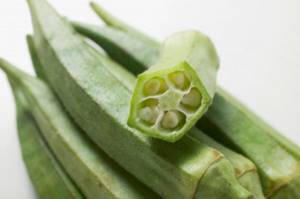
The older the okra, the coarser its pulp becomes, but you can wait until it is fully ripe, dry the peas, and then grind it, it turns out to be a good coffee substitute.

More goodies: Zucchini dishes with minced meat in the oven: recipes with step-by-step photos Zucchini is a wonderful vegetable in terms of the fact that it has a neutral taste, which means it can be combined with different...
Distribution area
Today it is quite difficult to establish exactly where this plant first appeared. Most likely, this is India or West Africa - this is where you can find the largest number of varieties - both cultivated and wild.
White people became acquainted with it after the Crusades - in Europe they began to cultivate it (albeit not everywhere) back in the 13th century. But it came to Russia much later - okra became relatively widely known only recently. However, there is evidence that the writer A.P. Chekhov was engaged in growing it at his own dacha in the Moscow region.
Benefits of the plant
Let's start with the fact that okra contains a huge amount of valuable microelements. These include: manganese, magnesium, iron, phosphorus, calcium, copper, potassium. Among the vitamins it contains K, PP, as well as several B group.
It is also worth noting that okra is the same valuable source of fiber as, for example, some sweet fruits and berries: strawberries, apricots. Fiber content is about 3.5%. Thanks to this, when consumed as food, it perfectly removes harmful toxins and carcinogens from the body, and can also bring considerable benefits in the prevention of flatulence and constipation.
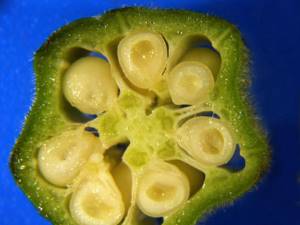
Some experts claim that okra lowers blood sugar levels, which means that consuming it will be very beneficial for diabetes.
Possible harm
However, okra is not only a healthy and tasty product, but also a possible source of allergies. Therefore, you need to take certain precautions so that the fruits do not bring unnecessary problems.
To begin with, it is very important to remove hairs from the surface of the fetus - they are the ones that in some cases cause an allergic reaction. This is not difficult to do - just rinse the pods well and rub them firmly with your fingers or a rough sponge.
Additionally, some older pods can be quite hot. This effect is eliminated with high-quality heat treatment. After all, some people, especially those on a diet, cannot afford to eat spicy food.
No other contraindications or negative consequences have been identified, so okra (okra) can be safely eaten.
Varieties and varieties of okra
Today there are several varieties and varieties of okra, which are very popular in the Russian Federation. Each fruit differs from others in shape and size.
What types of plants are there:
- The oak forest is low-growing. The stem of this plant grows up to 80 centimeters. The lower foliage on the stem has a five-lobed shape, and the upper foliage is dissected. The flower of this species is yellow in color and small in shape (9 centimeters in diameter). The color of the ripe fruit becomes dark green. The height of okra can vary, but on average the plant reaches 18-20 centimeters. Such a crop can produce about 8 fruits, from which it is then possible to obtain seeds for planting for the next period. Each fruit contains approximately 50 seeds.
- Lady fingers. Okra pods and seeds are completely edible. For this reason, people grow the crop to obtain a tasty delicacy from which they can prepare more than one dish. The plant grows up to 1 meter. After planting the plant in open ground and until the first fruits are received, at least 100 days pass. There are sparse hairs on the stem of the lady's finger. The fruits of this crop externally resemble capsicum, covered with fibers. To remove them, you need to wipe the fruits with a rough piece of cloth. The fruits themselves are hidden in the axil of the foliage. Interestingly, this variety is very resistant to heat and dry weather. It is possible to harvest fruits from this species twice a year, but subject to a warm climate. It is advisable to eat the slightly unripe fruit, as it contains a sticky mass used to thicken various dishes. In addition, okra fruits are added to vegetable salad, side dish or soup. This vegetable can be canned, frozen or dried. Eating this variety is useful for people on a diet and patients with atherosclerosis.
- The oak forest is mid-season. Immediately after planting the plant in the ground, at least 65 days pass until the first ovaries appear. It will take about 120 days for the seeds to appear in them. Okra of this variety bears fruit for approximately 1 month. During this time, harvesting can be carried out about 7-9 times. This variety is planted exclusively in open soil. The ovary can be eaten by people who are on a diet.
- Medium-sized pipe. The stem of this plant reaches a height of 120 to 150 centimeters. The color of the inflorescences is yellowish, and the size is up to 7 centimeters. The fruits have a greenish tint and their size is no more than 20 centimeters. To get seeds from a fruit, 10 copies are enough. The first ovaries are formed already on the 70th day after planting the crop in the ground. The seed ripening period is 125 days. This variety of okra takes approximately 35 days to bear fruit, resulting in about 9 harvests per year.
In addition to the listed varieties, there are also others that are in great demand in the Russian Federation, namely White Velvet and White Cylindrical Okra. Many summer residents prefer to plant these crops in their garden plots. This is explained by the fact that the listed varieties produce very tasty and incredibly healthy fruits.
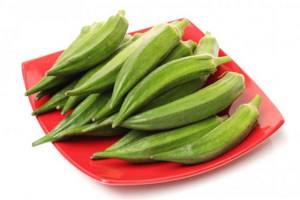
How to cook it correctly
The taste of okra, a photo of which can be seen in the article, most closely resembles eggplant or asparagus. You can cook both fresh fruits and frozen ones - but the benefits are practically not reduced, since okra does not contain those vitamins that decompose when frozen.
Be prepared for the pods to release a large amount of mucus when cooked. Don’t be afraid - they contain oil, which is released in this way during heat treatment. However, in a soup or stew this is practically unnoticeable, and such mucus does not spoil the taste at all.

You can prepare the pods in a variety of ways - the fruits are stewed, fried, boiled. You can make a salad from fresh ones. Some gourmets even deep-fry them. So okra will be an excellent addition to vegetable stew or soup, and can also enrich the menu of people who love to pamper their loved ones with delicious and healthy steamed vegetables.
Young leaves are also used. Most often they are added as a dressing to soups, and sometimes, after thoroughly washing and finely cutting, they are used to dress salads.
Roasted and ground seeds can be used to make a coffee substitute that tastes similar to coffee but is completely free of harmful caffeine.
Unripe seeds can be pickled, just like green peas. From ripe ones, oil is extracted - very tasty, with a pleasant smell and rich in unsaturated Omega-6 fats. It tastes like olive oil.
Cosmetic properties of okra
Historical documents say that the beauties of the Ancient world - the Egyptian queen Cleopatra and the Chinese woman Yang Gui Fei, glorified in classical literature - were very fond of eating okra. Who knows, maybe the secret of their beauty is hidden in it.
Here are some beauty recipes using okra.
Decoction for strengthening hair.
A decoction of okra pods is great for strengthening hair and giving it silkiness and a mirror-like shine. You need to cut the pods into strips and boil them so that the liquid becomes as slimy as possible. Use the decoction as a hair balm.
Face cream with okra extract.
If okra extract is added to a face cream, the resulting cosmetic product can be used to protect the skin from acne and unevenness.
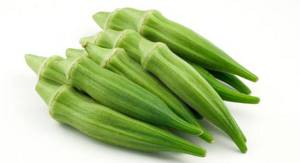
Choosing good okra
Not everyone wants (or has the opportunity) to grow a plant in their dacha. But many gourmets would be interested in trying it. Fortunately, today you can often see various exotic fruits on the market, including okra. However, they are not always of really high quality and tasty. Therefore, it would be useful to know certain subtleties that will allow you to choose the right product.
First of all, you should discard fruits that are too large. The optimal length is from 5 to 10 centimeters. Larger ones are most likely overripe. They have a rather rough shell, which will remain hard even after prolonged heat treatment - such an addition may well ruin any dish.
The fruits should be deep green. If the color is pale, it means that they were most likely grown in a greenhouse and do not have the taste they should. And they will be of little use.
By touch you should choose strong, dense pods. Of course, immediately discard those that are wrinkled, limp, have rot, damage or mold. The simplest and most reliable test is to break one pod. When slightly bent, a high-quality fruit breaks with a barely audible crunch.
By choosing such okra, you can be sure that you are getting a quality product that can make your dishes more tasty and varied.
Description
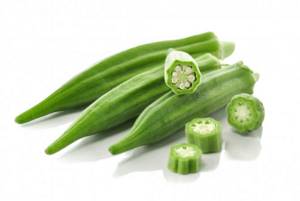
Okra is an annual herbaceous plant that can grow up to 40 cm in height. However, there were also cases when the vegetable could reach a height of 2 meters. Okra has a very thick branched stem, and the leaves are slightly drooping and light green in color. The leaves are either five-lobed or seven-lobed. Okra flowers are quite large and have a yellow-cream color. They are often located on stalks in the axils of the leaves and this is where fruit formation occurs. The fruits are popularly called capsules, as they have an 8-sided shape and contain seeds inside. There are also pods here.
Many people compare okra to eggplants. This plant really needs similar care. Okra requires heat, so it has gained great popularity in the southern regions. However, currently the situation has changed somewhat and now it can be grown in any country. Okra can be found on store shelves fresh or frozen. The fruit is also found in markets. Harvesting most often occurs between August and November.
We grow in the country
Alas, it is not possible to grow okra in open ground in all regions of our country - after all, it is a heat-loving plant that originated in the tropics or subtropics. Therefore, in most places you will have to use a greenhouse. But, for example, in the Krasnodar Territory and Crimea, okra can be easily grown in open ground, resulting in a rich harvest.
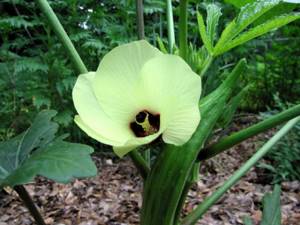
If you don’t have a greenhouse, but want to try to master a new crop, it’s best to start by sowing seedlings. First of all, you need to choose quality soil. A mixture of compost and black soil is suitable - you can purchase both without much difficulty at any gardening store.
The okra plant does not like picking. It has a rather fragile root system that is easily damaged during transplantation. This is very important to consider if you want to get a rich harvest of pods. It is best to use special paper cups, freely sold in specialty stores.
Having filled them with soil, water it generously and leave for a day in a warm place: from +20 °C to +25 °C. This temperature is considered optimal for growing okra.
The seeds need to be soaked in warm water. Immediately select those that float on the surface or in the water column - they will not hatch and will only take up the pot in vain.
Sprouts appear quite quickly. They need to be watered regularly, and some experts also recommend spraying them generously - after all, this is a tropical plant accustomed to high humidity. In the dry air of the apartment, the rate of development decreases.
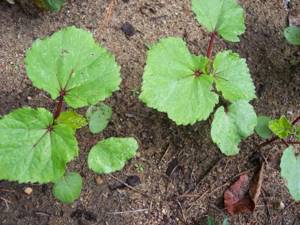
Planting begins approximately 45 days after sowing. By this time, the seedlings become quite large, with a developed root system. Take this into account, as well as the climate in a particular area, so that the last frost of the season has already passed and does not pose a danger to the plant.
It is recommended to plant in beds together with cups, at a distance of 30 to 60 centimeters, depending on the variety.
Dish recipes
Here is a description of some okra dishes.
Chicken breast with okra
Simmer fried chicken pieces in gravy prepared in the following ways:
- fry the onions, carrots, tomatoes together, removing the skins, okra and bell peppers for 15 minutes, without stirring them; a minute before readiness, add finely chopped garlic to the sauce;
- stew okra in white wine with Provençal herbs.
Meat in a pot
Pork or beef meat is cut into pieces and laid out on a layer of okra placed in a fireproof container. Another layer of vegetables is placed on top, which are filled with the following sauces of your choice:
- tomato juice with basil, garlic and thyme with oregano;
- soy sauce with garlic and ginger.
All this is stewed in the oven, then served with rice.
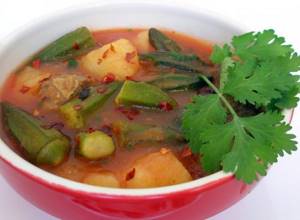
Bhaji - Indian vegetarian snack
- onions, garlic and ginger are fried in a frying pan;
- then a little water is added there, where the mixture is simmered for 10 minutes;
- it is crushed in a blender. The resulting mass is simmered with tomato paste, turmeric, salt and water until medium thick for 10 minutes;
- okra pods cut into two-centimeter pieces are boiled and fried for 5 minutes;
- then simmer for another 5 minutes in the previously prepared sauce;
- the final touch - spices (chili, coriander) are added to the dish, everything is mixed and removed from the heat;
- Before serving, the dish is sprinkled with lemon juice.
How to care for her
Caring for okra is quite simple - you need to care for tomatoes, eggplants and peppers in the same way.
First of all, you need to water the seedlings regularly - at least twice a week. If the days are hot, the number of waterings should be increased to 3-4 times a week. However, with regular rains and soil that retains moisture well (not sandy), you can do without watering or with one watering per week.
Weed control is also natural - especially in the first stages, when weeds may well choke young okra seedlings.
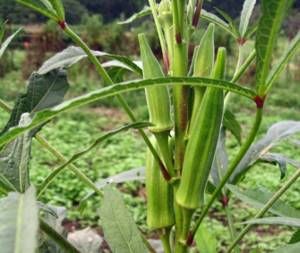
When the bushes become tall enough and begin to fall apart in different directions, you need to carry out hilling - an experienced farmer will not have problems here, because the principle is the same as when growing potatoes.
Finally, we must not forget about fertilizer. The okra vegetable, the photo of which you see in the article, needs to be fertilized twice. Before flowering, mineral fertilizers are needed. And when the ovary appears and the pods begin to actively grow, potassium nitrate is better suited.
As mentioned above, pods are formed regularly - from about the end of July until the end of September (if frosts do not hit earlier). Therefore, there is no need to save money - pick fresh pods from the bushes and eat them immediately.
We store the product correctly
Okra is quite difficult to store. It is rarely possible to keep fresh fruits for longer than three days. Therefore, it is better to freeze the excess immediately - just rinse the pods, place them on a towel or paper to get rid of moisture, and immediately put them in the freezer.
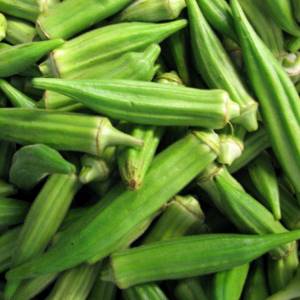
Fresh fruits can be stored in a paper bag in the refrigerator.
